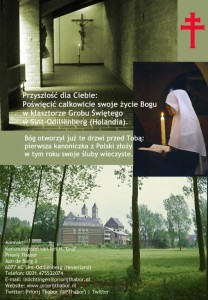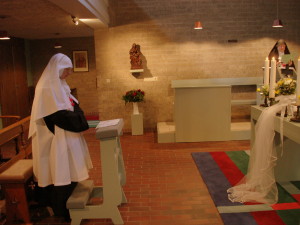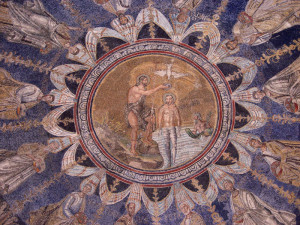“Why I chose Sint-Odiliënberg? To live for God!”
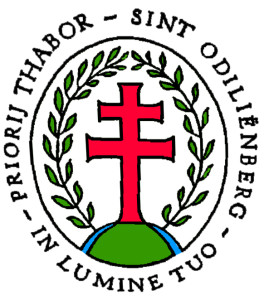
Canonesses Regular of the Holy Sepulchre
Priory Thabor
Sint Odiliënberg, the Netherlands
“Why I chose Sint-Odiliënberg? To live for God!”
Who are we?
The Canonesses of the Holy Sepulchre who live in Priory Thabor are a Roman Catholic religious community. The love for God and fellow human beings has a central place in their lives, following the example of Christ, who died and was resurrected. They respond to the love of God for humanity by turning to God frequently throughout the day in liturgical and personal prayer, to thank him for creation and its preservation and for His love for every individual human being. In the awareness that Jesus Christ, the Son of God, has redeemed mankind from sin and death, and that Jesus has shown us God, the sisters wish to constantly ponder Jesus’s life, suffering, death and resurrection from death in their prayers and follow Jesus in daily life. They believe that living evangelically means praying on behalf of the world and for the world and being there to the best of their ability for all those who call upon their help.
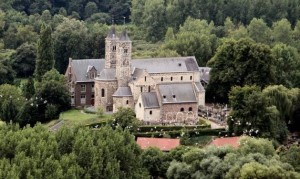
Sacred place
Sint Odiliënberg, which used to be known as Sint Petrusberg, is situated like a precious gem on the meandering Rur River in the southernmost province of the Netherlands. The grey Chapel Hill with the unassuming Roman baptistery, devoted to the Mother of God, and the basilica marked by two slender spires, create a picturesque scene. In the background the Priory of the Holy Sepulchre can be seen.
Between the baptistery in the north and the monastery of the Holy Sepulchre in the south – tension-filled poles of birth, death and resurrection – the basilica rises like a monumental figure of the full life, built on the gospel and confirmed in faith. Numerous are the saints who are venerated in this house of worship. Their images and symbols keep the spiritual history of the old and renowned Chapel Hill on the Rur River alive up to the present day.
On the crown of the ancient hill, almost everything testifies to a life consecrated to God. Children are baptised there, marriages are contracted, evangelical counsels are practiced, confessions are heard, the despondent are comforted, prayers are poured out and the dead are buried. Above all, the happiness of the Alleluia, the joy of the Credo and the joyous conclusion of the Ite, missa est murmur in the sacred spaces and over the hill and surrounding land. The consolation of the Secret of the Eucharist provides life on the hill with the calm gleam of eternity, where heaven and earth meet.
In the eighth century, one of the Frankish Pippins, the ancestor of Charles the Great (768-814), gave this place to the Anglo-Saxon monks Wiro, Plechelmus and Otger, who were subsequently declared sacred; it served as a base for their missionary work in the regions between the Meuse and Rhine rivers.
This is also where, in the ninth century the bishop of Utrecht with his chapter of canons, found a safe haven while on the run from the Norsemen. In the 15th century, this Hill was given to the Canonical Order of the Holy Sepulchre to “establish a regular nunnery”. This is where the priest-canon Jan van Abroeck who, averse to all comfort and worldly splendour, was committed with heart and soul to the ideals of the Order of the Holy Sepulchre, laid the foundation for the nunneries of the Holy Sepulchre, which would spread across Western Europe in subsequent centuries. His motto was: God’s will and honour.
In 1888, the monastic tradition on the Hill was revived, and to the present day a small community of canonesses of the Order of the Holy Sepulchre lives in a monastery on the Chapel Hill on the Rur River, bearing the name Priory Thabor. The worldly authorities in the Netherlands also recognise the great cultural-historical value of the Hill. The Hill, church, monastery and rectory are jointly classified and protected as national heritage, undergoing a large-scale renovation in 2015.
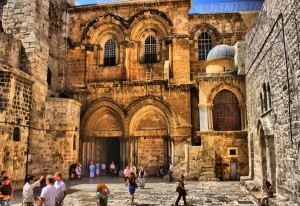
Origin of the Order
Among the canonical Orders of canons and canonesses, the Order of Canonesses Regular of the Holy Sepulchre distinguishes itself by its substantial involvement with the Holy Sepulchre of the Lord in the Basilica of the Resurrection in Jerusalem, with which it is closely affiliated through historical and spiritual ties. The canonical Order of the Holy Sepulchre is a monastic order and is to be distinguished from the Equestrian Order of the Holy Sepulchre, which was created much later and is a lay order.
The canonesses of the Holy Sepulchre are the spiritual heirs of the Latin chapter of canons which, after the capture of Jerusalem by Godfrey of Bouillon during the First Crusade, was assigned the ministry of the Holy Sepulchre church in 1099 in order to provide the liturgical ceremonies there: celebrating the Holy Eucharist and singing the Hours according to the Latin liturgical rites as a special assignment.
Under the influence of the ecclesiastical reform movement, known as the Gregorian Reform, the chapter adopted the Rule of St. Augustine in 1114 to live in community of property henceforth as a monastic community. They further outlined their precepts in accordance with their own Constitutions. In 1122, the Order of the Sepulchre was recognised by Pope Callixtus II as Order of Canons Regular of the Holy Sepulchre in Jerusalem. The canons restored the dilapidated church of the Holy Sepulchre and ensured the preservation of the Holy Places in the Holy Land. They also taught religious and liturgical practices to children, received pilgrims, assisted the poor and taught them the truths of faith.
Pope John Paul II visited the Holy Sepulchre church in Jerusalem on 26 March 2000 and said in his sermon then: “Here, in the church of the Holy Sepulchre, the Holy Sepulchre is empty. It is a silent testimony of the central event of the entire history of mankind: the Resurrection of our Lord Jesus Christ. For almost two thousand years, the empty sepulchre has borne witness to the victory of Life over death. The Resurrection of our Lord Jesus Christ is the sign that the eternal Father is loyal to his promise and resurrects new life from death.”
 \
\
Monastic life in Sint Odiliënberg in the present day
The ancient spirituality of the Holy Sepulchre lives on in Sint Odiliënberg to the present day. Through the daily celebration of the Liturgy of the Hours (lauds, matins, terce, sext, none, vespers and compline), the canonesses comply with the first objective of their Order: praising God for the boon of redemption and singing the glory of the Resurrection of the Lord. Apostolic life, the activities and the service are passed on to fellow human beings through this monastic ideal, but also through a diligent focus on conversion of the heart to God.
In our time – in which, on the one hand, God is excluded from the thoughts of people, and in which, on the other hand, people long for redemption from a senseless existence and for lasting happiness, which can only be found in God – the testimony of this spirituality is very valuable, certainly in secularised Western Europe. The PASCHAL MYSTERY, the high point of all Liturgy, is central in canonical life of the Order after all.
This Order’s spirituality is closely aligned to the general ecclesiastical spirituality as also expressed by the 2nd Vatican Council in the Constitution on the Holy Liturgy. Without cessation, we also convene daily for the celebration of the Paschal Mystery in order to read what relates to Christ in all the Scriptures, to celebrate the Eucharist in which the victory and triumph of his death are made present, and also to give thanks to God in Christ for his untold gifts to the praise of his glory by the power of the Holy Spirit. (Cf. Sacrosanctum Concilium No 5).
In the same way the Holy Eucharist is the heart of ecclesiastical life, it is also that of consecrated life. It is the daily provision and the source of spirituality. By means of the Eucharist, every consecrated human being is invited to experience Christ’s Paschal Mystery, and to unite with Him through dedicating their own life to the Father through the Holy Spirit. Thus, the life of the religious becomes a continuous worship to God in love.
Inseparably linked to this is Christ’s commandment of neighbourly love “that is bestowed upon us by Him, who says: Just as I have loved you, you also are to love one another. By loving us, he bestowed upon us this: that we would be united by a mutual bond of love, and that we would form the body of such a Head through this very soft bond of mutual love between the limbs”. (cf. H. Augustine, Treatise 65,3 on the Gospel of John).
In the same way as the Apostles on Mount Tabor rejoiced in and were strengthened by beholding the glory of the Lord, in order to be able to remain loyal in the worst suffering, the Holy Sepulchre sisters of the Priory Thabor on the chapel hill also find their joy and strength in the presence of the Resurrected Christ in the Liturgy of the Church and the Eucharistic adoration.
Moreover, the Liturgy is inspirational for a life of unity (Christian life = community life), personal prayer and a commitment to fellow human beings. Children and adults from far and wide flock to the monastery for religious teaching, in preparation for the Sacraments, but also if they wish to become Roman Catholic.
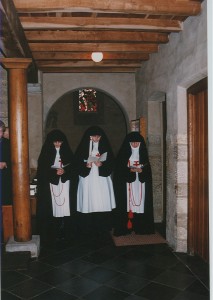
A focus on the future
The community is autonomous with Constitutions approved after Vatican II, but has become very small at this point. Despite the limited number of the religious (7), we strive with all our energy to experience consecrated life with its minor and major implications, expressed, not only in the wearing of the religious attire, maintaining the papal clausura and preserving the traditions of the Order, but also in loyalty to the Roman Liturgy (Latin and Gregorian chant) in full communion with and obedience to the Church and the Pope.
We hope and pray that respectable ladies are called by Our Sweet Lord to augment our monastery, enabling us to pass on the treasures of our rich tradition in the praising of Christ and his Church and the salvation of our fellow human beings in the coming time as well (cf. Sacrosanctum Concilium No. 7).
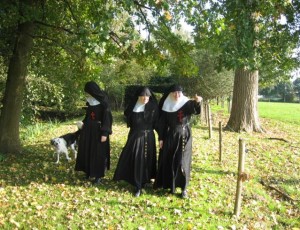
One of our sisters wrote about her history of vocation on our web blog:
I became aware that God was the great focal point in this monastery. It was a revelation to me and the Latin also did not pose any obstacle to me, even though it initially resembled Chinese! Tears surreptitiously ran down my cheeks. In the evening, during Compline, the response “In manus tuas, Domine, commendo spiritum meum” – Into thy hands, O Lord, I commend my spirit – was sung, and this was the decisive factor, this was it. The certainty that God gave me then, I cannot describe with words, but I did know from that point and still do: Sint Odiliënberg is my dream. This monastery is my home.
We are very happy to welcome young(er) ladies / girls who wish to orientate themselves on the question of whether our life path is also their path unto life to which they are called by Christ. Languages other than Dutch are not a problem. We speak Dutch, German, French and English, and our youngest sister is from Poland. She also additionally speaks Russian.
Information:
Canonesses Regular of the Holy Sepulchre
Sister M. Jacqueline
Priory Thabor
Aan de Berg 3
NL 6077 AC Sint Odiliënberg
Telephone number: 0031 (0) 475 532074
E-mail: zr.jacqueline@priorijthabor.nl
Website: www.priorijthabor.nl
Weblog: priorijthabor.blogspot.com
Twitter: @PThabor
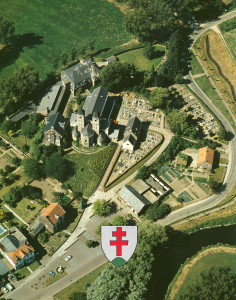

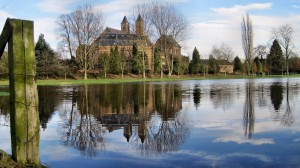
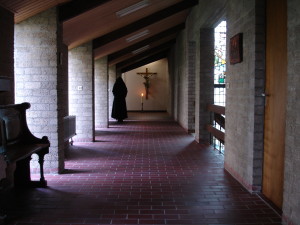 De blik gericht op de toekomst
De blik gericht op de toekomst